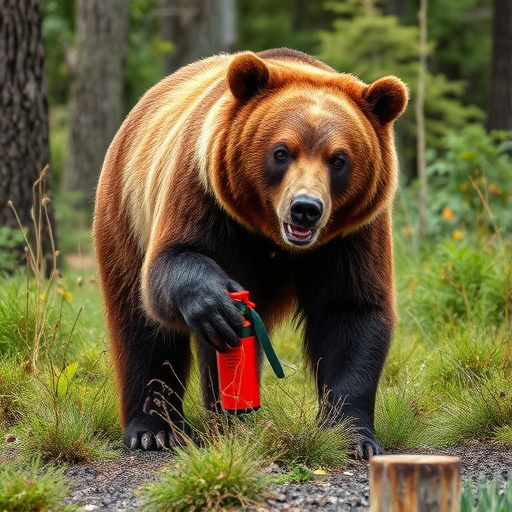The Environmental Effects of Bear Spray Decomposition involve chemical byproducts impacting soil and ecosystems. Responsible use and disposal are crucial to prevent harm to non-target species, aquatic organisms, and soil quality. Active ingredients breakdown naturally but persistence raises concerns about water pollution and toxicity, especially in sensitive habitats, highlighting the need for sustainable practices.
“In regions where human-wildlife conflict is prevalent, bear spray has emerged as a popular defense mechanism. This article delves into the effectiveness of bear spray as a predator deterrent, focusing on its composition and efficacy. We explore the environmental impact of bear spray ingredients, examining their decomposition process and potential soil contamination. Furthermore, we discuss the long-term effects of these substances on ecosystem balance, highlighting the need for understanding their environmental effects in light of increasing human activity.”
- Understanding Bear Spray Composition and Efficacy
- Environmental Impact of Bear Spray Ingredients
- Decomposition Process and Soil Contamination
- Long-term Effects on Ecosystem Balance
Understanding Bear Spray Composition and Efficacy
Bear spray, also known as urushiol-based spray, is a popular defense mechanism against predators like bears. Understanding its composition and efficacy is crucial when considering its use for safety in wild environments. The primary active ingredient, urushiol, is a natural compound derived from plants like poison ivy, which causes skin irritation and redness upon contact. When sprayed towards a bear, it creates a barrier that can deter the animal, providing valuable time for escape or evacuation.
The environmental effects of bear spray decomposition are relatively minimal compared to its immediate impact on predators. Urushiol breaks down over time, usually within a few weeks to months, depending on weather conditions. This breakdown occurs through natural processes such as enzymatic activity and UV radiation, ensuring that the spray doesn’t leave behind persistent chemical residues in the environment. It’s important to note that proper use and disposal methods are essential to minimize any potential impact on non-target species and ecosystems.
Environmental Impact of Bear Spray Ingredients
The ingredients in bear spray, while effective as a defense mechanism, can have notable environmental impacts once they decompose. These products typically contain capsaicin, a chemical derived from chili peppers, along with various solvents and other additives. When used correctly, the spray creates a temporary but powerful deterrent against predators like bears by irritating their eyes and respiratory system. However, improper disposal or accidental release into ecosystems can lead to harmful consequences for wildlife and plant life.
The Environmental Effects of Bear Spray Decomposition are complex. Capsaicin, when introduced into aquatic environments, can disrupt the behavior and physiology of fish and other water-dwelling organisms. Solvents used in the spray may contaminate soil and groundwater, potentially affecting non-target species and disrupting local ecosystems. Understanding these environmental factors is crucial for promoting responsible usage and disposal practices to minimize the impact of bear spray on our natural surroundings.
Decomposition Process and Soil Contamination
The environmental effects of bear spray decomposition are a critical consideration when discussing its use as a defense mechanism against predators. When bear spray is deployed, it doesn’t simply disappear; rather, it undergoes a complex decomposition process that can impact the soil and surrounding ecosystem. This process involves several stages where chemical compounds break down, eventually transforming into various byproducts.
The primary concern lies in the potential soil contamination caused by these decaying compounds. Bear spray’s active ingredients, which are designed to deter predators, might leach into the soil, affecting microflora and fauna. Over time, repeated use or improper disposal could lead to cumulative environmental impact, highlighting the need for responsible handling and disposal methods. Understanding these environmental effects is crucial to balancing wildlife protection with minimizing ecological disruption.
Long-term Effects on Ecosystem Balance
The long-term environmental effects of bear spray decomposition are a critical consideration in understanding its impact on ecosystems. When used responsibly, bear spray can be an effective defense mechanism against predatory bears, providing a safety net for individuals and communities coexisting with these majestic animals. However, improper usage or excessive application can lead to ecological imbalances. The active ingredients in bear spray, once released into the environment, undergo natural decomposition processes. Over time, these chemicals may impact non-target species and alter the delicate balance of ecosystems.
Research suggests that the environmental effects of bear spray decomposition are complex. While some components break down relatively quickly, others can persist in the environment for extended periods. This longevity raises concerns about water pollution and potential toxicity to aquatic life, especially in areas with high biodiversity and sensitive habitats. Understanding these long-term impacts is crucial for developing sustainable practices around the use of bear spray, ensuring its role as a protective measure does not inadvertently disrupt the ecosystem’s harmony.
The environmental impact of bear spray ingredients, while offering a valuable defense mechanism against predators, is an important consideration. Understanding the decomposition process and potential soil contamination is crucial for assessing the long-term effects on ecosystem balance. As we navigate the use of bear spray in wildlife management, it’s essential to strike a balance between human safety and preserving the delicate tapestry of nature’s ecosystems. The ongoing research into the environmental effects of bear spray decomposition plays a vital role in shaping sustainable practices that protect both humans and wild habitats.
